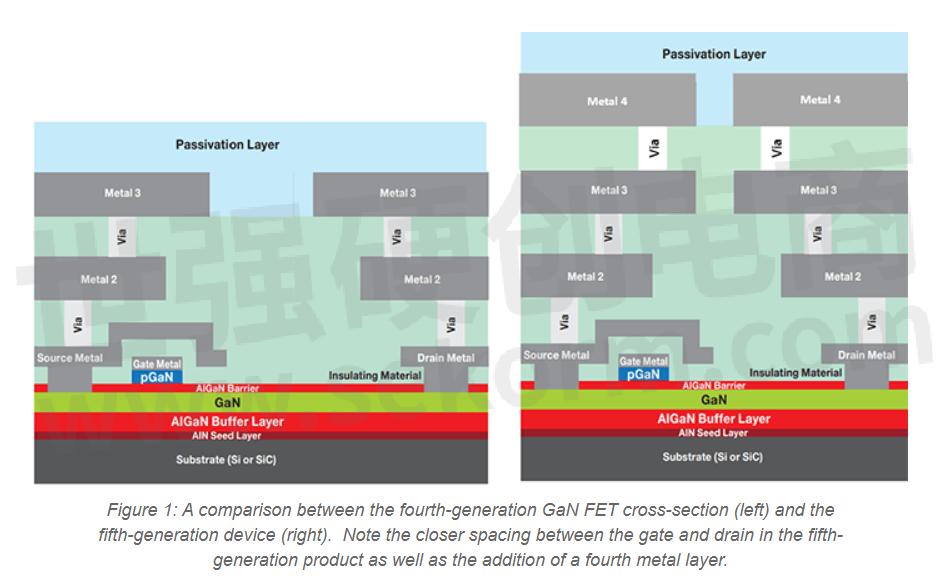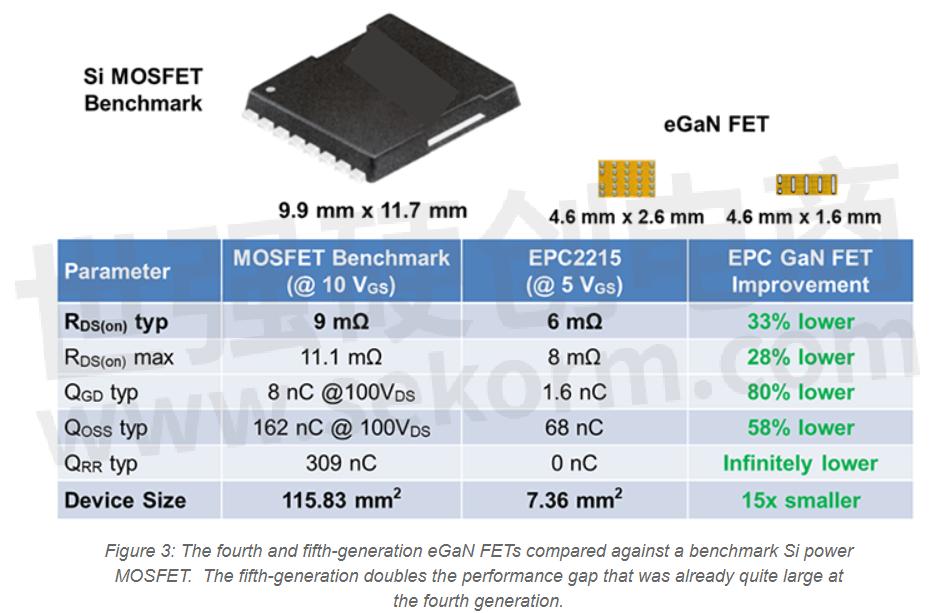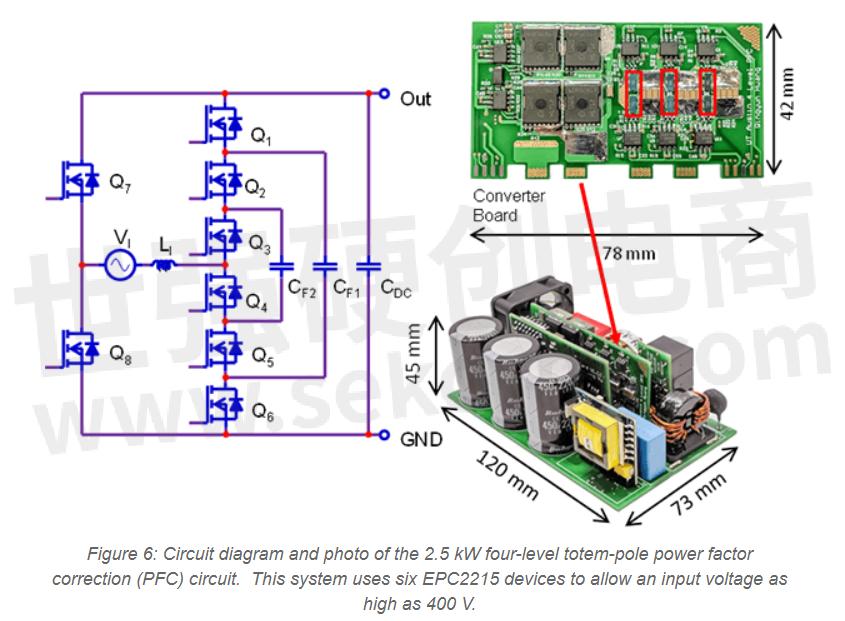EPC‘s New 200 V eGaN FETs Double The Performance Edge over The Aging Silicon Power MOSFET

Efficient Power Conversion (EPC) is doubling the performance distance between the aging silicon power MOSFET and eGaN® transistors with 200V ratings. The new fifth-generation devices are about half the size of the prior generation. This performance boost comes from two main design differences, as shown in figure 1. On the left is a cross-section of the fourth generation 200 V enhancement-mode GaN-on-Si process. The cross-section on the right is the fifth-generation structure with reduced distance between gate and source electrodes and an added thick metal layer. These improvements, plus many others not shown, have doubled the performance of the new-generation FETs.

The first two products, EPC2207 and EPC2215, are shown in figure 2 and are compared against the prior generation eGaN FETs. For example, the EPC2207 is 2.6 mm2 compared with the EPC2010C at 5.8 mm2, yet the EPC2207 has lower RDS(on), lower QG, QGD, and much lower QOSS.

To illustrate the significant performance advantage over Si power MOSFETs, figure 3 compares both the fourth generation and fifth generation eGaN FETs against a benchmark silicon device, the IPT111N20NFD from Infineon. The EPC2215 has 33% lower RDS(on), yet is 15 times smaller in size. Gate charge (QG) is more than six-time smaller with the new technology, and like all eGaN FETs, there is no reverse recovery charge (QRR) enabling lower distortion class D audio amplifiers as well as more efficient synchronous rectifiers and motor drives.

Additional confirmation of the advantages of the new-generation 200 V eGaN FETs seen in the performance graphs in figure 4. Shown is a comparison between the Infineon 200 V MOSFET benchmark device, the older-generation EPC2034C, and the fifth-generation EPC2215. The EPC2215 performs better than the older EPC2034C despite being 60% the size. The Si MOSFET has a clearly inferior performance.

With devices as small as these new generation eGaN FETs, a common question is how well they can dissipate heat in operation. Thanks to the chip-scale packaging, thermal efficiency is much higher than the comparable silicon device in a package. As an example, in figure 5 is a 4 mm2 eGaN FET showing 4 °C/W thermal resistance with 6 W power in the device. We show a simulated image for clarity, but the actual capability of the device was experimentally confirmed.

With the clear superiority of these new 200 V eGaN FETs, one might expect them to be priced at a premium. However, EPC has priced these state-of-the-art transistors comparable with their aging ancestor, the silicon power MOSFET.
The applications for these leading-edge devices include class D audio, synchronous rectification, solar MPPTs (maximum power point tracker), DC-DC converters (hard-switched and resonant), and multi-level high voltage converters.
In figure 6 is a 2.5 kW, 4-level totem pole PFC using only six EPC2215 devices. By stacking the 200 V rated eGaN FETs, the input voltage for this PFC can go up to 400 V and, as shown in figure 7, achieve 99.25% efficiency.


EPC’s fifth-generation eGaN FETs achieve higher performance in a smaller, more thermally efficient size, and at a comparable cost. In addition to the buck converter in figure 4, and the totem pole PFC in figure 6, these new-generation 200 V eGaN FETs are ideal for 49 VOUT synchronous rectification and class d audio applications. The inevitable obsolescence of the aging power MOSFET is becoming more evident every day.
- 【Datasheet】Enhancement-Mode Gallium Nitride Technology
- 【Datasheet】Enhancement-Mode Gallium Nitride Technology
- 【Datasheet】Enhancement-Mode Gallium Nitride Technology
- 【Datasheet】EPC2207 – Enhancement Mode Power Transistor
- 【Datasheet】EPC2207 – Enhancement Mode Power Transistor
- 【Datasheet】EPC2207 – Enhancement Mode Power Transistor DATASHEET
- 【Datasheet】EPC2207 – Enhancement Mode Power Transistor
- 【Datasheet】EPC2207 – Enhancement Mode Power Transistor DATASHEET
- 【Datasheet】EPC2215 – Enhancement Mode Power Transistor eGaN® FET DATASHEET
- 【Datasheet】EPC2215 – Enhancement Mode Power Transistor
- 【Datasheet】EPC2215 – Enhancement Mode Power Transistor
- 【Datasheet】EPC2215 – Enhancement Mode Power Transistor DATASHEET
- +1 Like
- Add to Favorites
Recommend
- Sharge Selects GaN FETs EPC2218 from EPC for High-power USB PD Charger Retro 67 to Achieve the Most Efficient Power Conversion
- New Automotive Qualified GaN FETs EPC2204A and EPC2218A for Vehicle Electronics and Advanced Autonomy from EPC
- Design Higher Resolution Lidar Systems with New Automotive-Qualified GaN FET EPC2252 for Advanced Autonomy from EPC
- Automotive AEC Q101 Qualified 65V eGaN FET EPC2219 Enables Higher Resolution for Lidar Systems
- EPC Introduces The 40 V, 1.6 Milliohm EPC2069 EGaN® FET, it Can Range From 500 W to 2 KW and Exceed 98% Efficiency
- EPC Introduces EPC9157 48V to 12V Demo Board Featuring EPC eGaN FETs and New Renesas DC-DC Controller
- EPC Announces a New 3-phase BLDC Motor Drive Inverter Using the EPC2065 EGaN® FET
- BRC Solar Selects EPC 100V eGaN FETs for Next Generation Solar Optimizer
This document is provided by Sekorm Platform for VIP exclusive service. The copyright is owned by Sekorm. Without authorization, any medias, websites or individual are not allowed to reprint. When authorizing the reprint, the link of www.sekorm.com must be indicated.





























































































































































































































































































































































































































































































































































































































































































































































































































































































